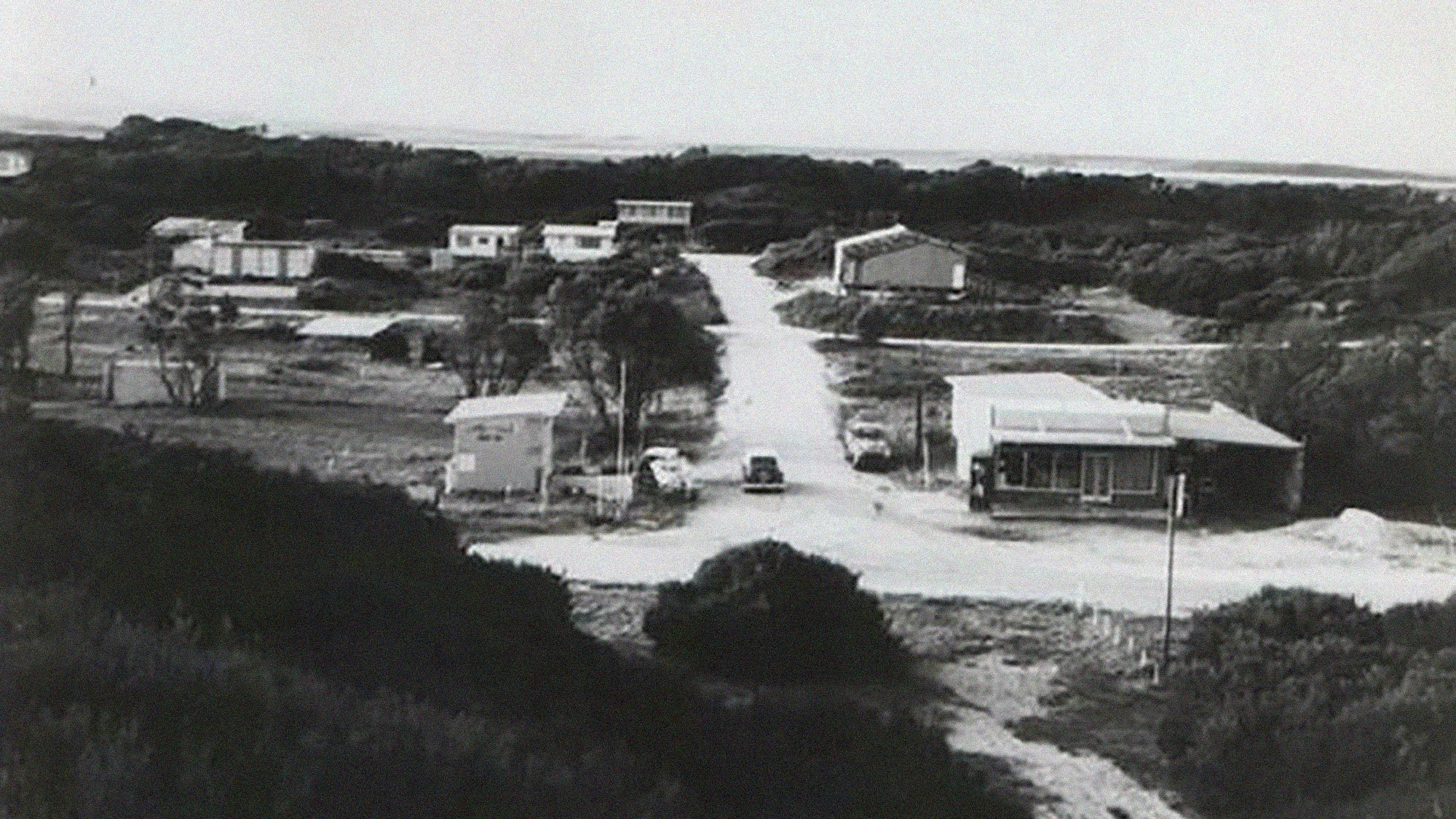
The township of Sandy Point
Sub-division of the Township
Early photo of the Real Estate office on Beach Parade built by Playground Estates Pty. Ltd.
The land that became Crown Allotment 21H and eventually the site of the Sandy Point subdivision had been previously classified as unsuitable for grazing and had not originally been included in the land selection scheme. However, this land was not fenced or separated from the ‘reserve’ which extended approximately from what is now Manuka Street to Shallow Inlet and cattle owned by various ‘reserve’ licensees freely grazed there.
Alan Kelly petitioned the Lands Department to make this piece of land available for use and eventually, it was surveyed and put up for selection. There were several interested parties including the Pilkingtons and Hendersons, but Alan Kelly was the successful applicant. The decision was appealed by three of the other applicants, but the appeal was dismissed and in 1949 Kelly was issued with a grazing licence. He later converted this to a lease and then on 21st November 1957, he obtained the grant of freehold.
Developers began taking an interest in the area as the potential for the development of a holiday resort became evident. Real estate agents Lachlan McInnes and Barry Bahen approached Alan Kelly and he agreed to sell the land to them. One can only imagine what the other residents of Sandy Point thought of this idea and whether they would have acquiesced to the development plan if they had been the successful applicant for Crown Allotment 21H.
Brochure produced by Playground Estates Pty. Ltd promoting the development and sale of blocks at Sandy Point.
During 1957 McInnis and Bahen had plans of subdivision drawn up and may have pre-sold some of the land to prospective purchasers. Alan Kelly obtained the Certificate of Title for the block in November 1957 and almost immediately transferred the title to McInnis and Bahen’s company Playground Estates Pty Ltd. Initially 155 blocks were offered to the public for £125 - £195. Some purchasers bought up several blocks with a view to selling them at a profit at a later time.
In 1958 Playground Estates contracted Roy Henderson to construct the roads in the new township. He used an old tank fitted with a bulldozer blade to clear the scrub and level the sandy ground. The blade can be seen on the track between Sandy Point and Shallow Inlet locally known as the “Tank Track” and officially named the Roy Henderson Trail. The Sandy Point roads were eventually sealed in the 1980s.
The old tank used by Roy Henderson to clear the scrub and construct roads throughout the new Sandy Point subdivision.
The Caravan Park and General Store
The Sandy Point Caravan Park and shop, circa1965.
In the early days when high numbers of holiday makers started to come to Sandy Point, they camped along the foreshore and on empty blocks. The Council and Foreshore Committee were concerned about the litter left by the campers and damage caused to the dunes and vegetation and encouraged the development of a Caravan Park. After this was opened in 1965 by Barry Bahen and ‘Mac’ McInnis camping along the foreshore was prohibited.
In 1962 the first General Store was opened by Norm Gerraty on the site of what is now the café. The Postal Agency was moved to the store from the home of Vi Pilkington (c. 1968) and Norm sold the store in the same year.
The store held a very basic range of tinned foodstuffs and did a daily pick-up of ice, milk and papers (that arrived in Fish Creek by train the day before) and fuel was available from a manual petrol bowser. In 1964 the store’s services were advanced by the addition of a generator to provide lighting and refrigeration for increasing number of ‘weekenders’.
Alan Worcester also operated a small store and milk bar adjacent to the Caravan Park (c.1965), which later became a takeaway and pizza shop. The building was demolished after a fire burned the kitchen down. In 1981 John Hall built the current General Store that also housed the post office and the original store was developed into a café by the Butterfields. There were also pinball machines and it was known locally as “The Pinny Parlour”.
The Waratah Beach Surf Lifesaving Club
A Royal Life Saving Club was first formed in the area in 1934. It did not have a club house at that time.
The Waratah Beach Surf Life Saving Club was founded in 1963 with just 6 founding members and their first clubhouse was built in 1968. Before the clubhouse opened, equipment was stored in a shed at the back of the General Store and carried over to the beach when required.
The current Waratah Beach Surf Life Saving Club building was built in 1999. By 2021, the club had over 600 active members
Community buildings and groups
In 1964 with the support of the real estate developers, the Waratah Beach Development Association (whose role was to promote Sandy Point and develop the village) started to build a hall on Surfer’s Parade on the site where the CFA shed now stands. This hall was never finished and eventually removed after the TP Taylor Hall was erected in 1965 on the corner of Beach Parade, where there is now a children’s playground.
Thomas P Taylor organised the relocation of an old wooden hut from Yallourn to Sandy Point in 1965 to provide a building where the community could meet. The tennis courts were built around the same time and they became the focus of community gatherings for many years. The first Sandy Point Community Group was formed there around that time. This group built a small playpark, a half-sized basketball court and picnic rotunda next to the tennis courts, where the current Community Centre now stands.
The old TP Taylor Hall was demolished in 2012 and in 2014 replaced by a new building, the Sandy Point Community Centre, which now hosts a great many clubs, events and activities. It is a designated “Neighbourhood Safer Place – Place of Last Resort” in the event of a bush fire and is run by the TP Taylor Reserve Committee of Management.
In 1984 a new CFA shed was built to replace the old shed constructed in the 1960s and house the new fire engine. This was demolished in 2002 and replaced by the CFA shed completed in 2004.
The Rob O’Brien Marine Search and Rescue Base was built in 2020 to house the Marine Rescue vessel and also provide a base for the newly established Men’s Shed.
Home | History of Sandy Point | Traditional Owners | European Settlers | Settlement at Shallow Inlet | Early Settler Life | Township of Sandy Point










